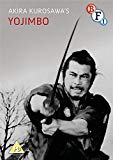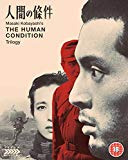![Battle Royale - Two Disc Special Edition [2001]](/pictures/1001813.jpg) Battle Royale - Two Disc Special Edition | DVD | (23/02/2004)
from £8.49
| Saving you £11.50 (135.45%)
| RRP
Battle Royale - Two Disc Special Edition | DVD | (23/02/2004)
from £8.49
| Saving you £11.50 (135.45%)
| RRP This ultra violent satire from Japan tells of 42 teenagers taken to a remote island where they are told that if they wish to survive they must kill all of the others!
![Battle Royale [DVD]](/pictures/1111426.jpg) Battle Royale | DVD | (03/10/2011)
from £5.99
| Saving you £4.00 (66.78%)
| RRP
Battle Royale | DVD | (03/10/2011)
from £5.99
| Saving you £4.00 (66.78%)
| RRP This ultra violent satire from Japan tells of 42 teenagers taken to a remote island where they are told that if they wish to survive they must kill all of the others!
![In the Realm of the Senses (1976) (Criterion Collection) UK Only - Original title: Ai no korîda [Blu-ray] [2021]](/pictures/1157442.jpg) In the Realm of the Senses (1976) (Criterion Collection) UK Only - Original title: Ai no korîda | Blu Ray | (03/01/2022)
from £19.98
| Saving you £N/A (N/A%)
| RRP
In the Realm of the Senses (1976) (Criterion Collection) UK Only - Original title: Ai no korîda | Blu Ray | (03/01/2022)
from £19.98
| Saving you £N/A (N/A%)
| RRP Still censored in its own country, In the Realm of the Senses (Ai no corrida), by the always provocative Japanese director Nagisa Oshima, remains one of the most controversial films of all time. A graphic portrayal of insatiable sexual desire, Oshima's film, set in 1936 and based on a true incident, depicts a man and a woman (Tatsuya Fuji and Eiko Matsuda) consumed by a transcendent, destructive love while living in an era of ever escalating imperialism and governmental control. Less a work of pornography than of politics, In the Realm of the Senses is a brave, taboo-breaking milestone. Special Features New, restored high-definition digital transfer (with uncompressed monaural soundtrack on the Blu-ray edition) New audio commentary featuring film critic Tony Rayns New interview with actor Tatsuya Fuji A 1976 interview with director Nagisa Oshima and actors Fuji and Eiko Matsuda, and a 2003 program featuring interviews with consulting producer Hayao Shibata, line producer Koji Wakamatsu, assistant director Yoichi Sai, and film distributor Yoko Asakura Deleted footage U.S. trailer New and improved English subtitle translation PLUS: A booklet featuring a new essay by Japanese film scholar Donald Richie and a reprinted interview with Oshima
![Kagemusha [Blu-ray] [1980]](/pictures/1125109.jpg) Kagemusha | Blu Ray | (17/03/2014)
from £N/A
| Saving you £N/A (N/A%)
| RRP
Kagemusha | Blu Ray | (17/03/2014)
from £N/A
| Saving you £N/A (N/A%)
| RRP The 1970s were difficult years for the great Japanese director Akira Kurosawa. Having been unable to secure full Japanese backing for his epic project Kagemusha, the 70-year-old master found American support from George Lucas and Francis Ford Coppola, who served as co-executive producers (through 20th Century Fox) for this magnificent 1980 production--to that date the most expensive film in Japanese history. Set in the late-16th century, Kagemusha centres on the Takeda clan, one of three warlord clans battling for control of Japan at the end of the feudal period. When their leader Lord Shingen (Tatsuya Nakadai) is mortally wounded in battle, he orders that his death be kept secret and that his "kagemusha"--or "shadow warrior"--take his place for a period of three years to prevent clan disruption and enemy takeover. The identical double is a petty thief (also played by Nakadai) spared from execution due to his uncanny resemblance to Lord Shingen--but his true identity cannot prevent the tides of fate from rising over the Takeda clan in a climactic scene of battlefield devastation. Through stunning visuals and meticulous attention to every physical and stylistic detail, Kurosawa made a film that restored his status as Japan's greatest filmmaker, and the success of Kagemusha enabled the director to make his 1985 masterpiece, Ran. --Jeff Shannon
![The Realm Of The Senses [1976]](/pictures/1020280.jpg) The Realm Of The Senses | DVD | (21/05/2001)
from £N/A
| Saving you £N/A (N/A%)
| RRP
The Realm Of The Senses | DVD | (21/05/2001)
from £N/A
| Saving you £N/A (N/A%)
| RRP Probably the most famous erotic film ever made, Oshima's masterpiece yields a fascinating conundrum: it's sexually explicit, but is it finally more about the mind than the body.
![The Human Condition [Blu-ray]](/pictures/1147430.jpg) The Human Condition | Blu Ray | (23/07/2018)
from £16.39
| Saving you £N/A (N/A%)
| RRP
The Human Condition | Blu Ray | (23/07/2018)
from £16.39
| Saving you £N/A (N/A%)
| RRP One of the towering masterpieces of Japanese and world cinema, this three-part war epic has rarely been seen in the UK, at least partly because of its dauntingly gargantuan nine hour length. Director Masaki Kobayashi (Harakiri) was attracted to Junpei Gomikawa s source novel because he recognised himself in the character of the protagonist Kaji, an ardent pacifist who came of age during the aggressively militaristic 1930s and 40s. In part one, No Greater Love, Kaji is relocated to a mine-supervising job in Manchuria, where he is horrified by the use of forced labour. Part two, Road to Eternity, sees him conscripted into the Japanese army and forced to fight in the name of an aggressively imperialist cause. Part three, A Soldier s Prayer, deals with the consequences of Japan s defeat, not least for Kaji himself. Throughout, Kobayashi unflinchingly examines the psychological toll of appallingly complex decisions, where being morally right risks outcomes ranging from ostracism to savage beating to death. As Kaji, Tatsuya Nakadai (Sanjuro) is in virtually every scene, providing a rock-solid emotional anchor and a necessary one in Japan, where the film was hugely controversial for being openly critical of the nation s conduct during WWII. But it s this willingness to confront national taboos head-on that makes it such a lastingly powerful experience. SPECIAL EDITION CONTENTS: High Definition Blu-ray (1080p) presentation Original Japanese mono soundtrack Optional English subtitles Introduction to the film by critic Philip Kemp Selected-scene commentary by Philip Kemp Theatrical trailers Reversible sleeve featuring two choices of artwork by maarko phntm
 The Face Of Another | DVD | (21/03/2005)
from £N/A
| Saving you £N/A (N/A%)
| RRP
The Face Of Another | DVD | (21/03/2005)
from £N/A
| Saving you £N/A (N/A%)
| RRP Facially scarred in a fire a businessman (Nakadai) receives psychotherapy and an amazingly lifelike mask. However he finds it difficult to re-integrate into society and discovers that his personal habits are changing. Is the mask controlling him or did he create the new personality of the mask? Director Hiroshi Teshigahara teamed up once more with screenwriter and novelist Kobo Abe and experimental composer Toru Takemitsu following their collaboration on the seminal 'Sunna No Onna'
 Yojimbo (DVD) | DVD | (12/06/2017)
from £15.85
| Saving you £N/A (N/A%)
| RRP
Yojimbo (DVD) | DVD | (12/06/2017)
from £15.85
| Saving you £N/A (N/A%)
| RRP This semi-comic 1961 film by legendary director Akira Kurosawa (Rashomon, Ran) was inspired by the American Western genre. Kurosawa mainstay Toshirô Mifune (Seven Samurai) is cast as a drifting samurai for hire who plays both ends against the middle with two warring factions, surviving on his wits and his ability to outrun his own bad luck. Eventually the samurai seeks to eliminate both sides for his own gain and to define his own sense of honour. Yojimbo is striking for its unorthodox treatment of violence and morality, reserving judgment on the actions of its main character and instead presenting an entertaining tale with humour and much visual excitement. One of the inspirations for the "spaghetti westerns" of director Sergio Leone and later surfacing as a remake as Last Man Standing with Bruce Willis, this film offers insight into a director who influenced American films even as he was influenced by them. --Robert Lane, Amazon.com
 Kwaidan (Masters of Cinema) Limited Edition Blu-ray | Blu Ray | (27/04/2020)
from £N/A
| Saving you £N/A (N/A%)
| RRP
Kwaidan (Masters of Cinema) Limited Edition Blu-ray | Blu Ray | (27/04/2020)
from £N/A
| Saving you £N/A (N/A%)
| RRP Winner of the Special Jury Prize at Cannes, Kwaidan features four nightmarish tales adapted from Lafcadio Hearn's classic Japanese ghost stories about mortals caught up in forces beyond their comprehension when the supernatural world intervenes in their lives: The Black Hair, The Woman of the Snow, Hoichi the Earless, and In a Cup of Tea. Breathtakingly photographed entirely on hand-painted sets, the film is an abstract wash of luminescent colours from another world. The Masters of Cinema Series is proud to present the complete 183-minute original Japanese cut of Masaki Kobayashi's masterpiece on Blu-ray for the first time in the UK. SPECIAL FEATURES Hardbound Slipcase 1080p presentation on Blu-ray from Criterion's 2K digital restoration of Kobayashi's original director's cut Original monaural Japanese soundtrack Optional English subtitles Kim Newman on Kwaidan a new interview with the film critic and writer Shadowings [35 mins] a new video essay by David Cairns and Fiona Watson Original trailers PLUS 100-PAGE Perfect Bound Illustrated Collector's book featuring reprints of Lafcadio Hearn's original ghost stories; a survey of the life and career of Masaki Kobayashi by Linda Hoaglund; and a wide ranging interview with the film maker the last he'd ever give
 What's Up Tiger Lily? | DVD | (02/02/2004)
from £28.71
| Saving you £-25.72 (N/A%)
| RRP
What's Up Tiger Lily? | DVD | (02/02/2004)
from £28.71
| Saving you £-25.72 (N/A%)
| RRP We took a Japanese film made in Japan with Japanese actors and actresses and I took out all the soundtrack and knocked out all the voices and I wrote a comedy. The result is a movie where people are running around doing all these James Bondian things but what's coming out of their mouths is something wholly other. It was done before actually in Gone With the Wind but not many people know that. Those were Japanese people actually and we dubbed in American voices Southern voices. But that was years ago. - Woody Allen
![High And Low [1963]](/pictures/1011276.jpg) High And Low | DVD | (28/03/2005)
from £18.75
| Saving you £1.24 (6.61%)
| RRP
High And Low | DVD | (28/03/2005)
from £18.75
| Saving you £1.24 (6.61%)
| RRP Kurosawa drew on the thriller 'King's Ransom' by Ed McBain (aka Evan Hunter) for this contemporary study of the inequalities and hierarchical rigidity of modern Japan. In the first half of the film set in a single room an industrialist agonises on whether to pay the huge ransom demanded by kidnappers who have mistakenly snatched his chauffeur's son instead of his own. The second half of the film shot in a frenzied restless style on sleazy urban locations concentrates on the polic
![Return From The River Kwai [1988]](/pictures/1002782.jpg) Return From The River Kwai | DVD | (04/06/2001)
from £4.98
| Saving you £-1.99 (N/A%)
| RRP
Return From The River Kwai | DVD | (04/06/2001)
from £4.98
| Saving you £-1.99 (N/A%)
| RRP True story of British and Australian POW's held by the Japanese in Thailand. Near the end of the war the fittest of the POW's were moved by rail and ship to Japan and during the sea journey the convoy comes under attack from an American submarine at the same time as the Allied POW's were making a daring attempt to take over the ship.
 The Human Condition Trilogy Dual Format Blu-ray & DVD | Blu Ray | (19/09/2016)
from £N/A
| Saving you £N/A (N/A%)
| RRP
The Human Condition Trilogy Dual Format Blu-ray & DVD | Blu Ray | (19/09/2016)
from £N/A
| Saving you £N/A (N/A%)
| RRP Kobayashi's monumental film can clarify and enrich your understanding of what it is to be alive. (A.O. Scott, New York Times) One of the towering masterpieces of Japanese and world cinema, this three-part war epic has rarely been seen in the UK, at least partly because of its dauntingly gargantuan nine-hour length. Director Masaki Kobayashi (Harakiri) was attracted to Junpei Gomikawa's source novel because he recognised himself in the character of the protagonist Kaji, a pacifist and socialist who came of age during the aggressively militaristic 1930s and 40s. Following Kaji's career from factory worker to Japanese army private, Kobayashi unflinchingly examines the psychological toll of appallingly complex decisions made along the way, where being morally right' risks an outcome ranging from ostracism to savage beating to death. As Kaji, Tatsuya Nakadai (Sanjuro) is in virtually every scene, providing a rock-solid emotional anchor and a necessary one in Japan, where the film was hugely controversial for being openly critical of the nation's conduct during WWII. But it's this willingness to confront national taboos head-on that makes it such a lastingly powerful experience.
![Rurouni Kenshin: Kyoto Inferno (Steelbook Edition) [Blu-ray] [Region Free]](/pictures/1134267.jpg) Rurouni Kenshin: Kyoto Inferno (Steelbook Edition) | Blu Ray | (06/04/2015)
from £26.98
| Saving you £N/A (N/A%)
| RRP
Rurouni Kenshin: Kyoto Inferno (Steelbook Edition) | Blu Ray | (06/04/2015)
from £26.98
| Saving you £N/A (N/A%)
| RRP Kenshin Himura is a legendary swordsman in the wars accompanying the turbulent fall of Japan’s Shogunate in the 19th century. Once feared as ‘Battosai the Killer’ he has adopted a peaceful life since the arrival of the ‘new age’ in Japanese history. But Makoto Shishio the ‘Shadow Killer’ who succeeded to Kenshin’s position in the service of the new government has since then been active in the Kyoto underworld.Because he knew too much of the dark side of the new government he was stabbed and his body set on fire. He survived however and wrapped in bandages has raised an army of disaffected former samurai with the aim of overthrowing the new regime. Agreeing to a request by Toshimichi Okubo the Home Minister Kenshin leaves his friends in Tokyo and sets out for Kyoto. He and Shishio are a match in skill and in wits but their aims are opposite. Kenshin seeks to preserve the nation without breaking his vow that he will kill no more.
![Rurouni Kenshin 3 - Steelbook [Blu-ray] [Region Free]](/pictures/1136788.jpg) Rurouni Kenshin 3 - Steelbook | Blu Ray | (24/08/2015)
from £36.43
| Saving you £-9.44 (N/A%)
| RRP
Rurouni Kenshin 3 - Steelbook | Blu Ray | (24/08/2015)
from £36.43
| Saving you £-9.44 (N/A%)
| RRP To stop Makoto Shishio who aims to conquer Japan Kenshin arrives in Kyoto and tries to face off against Shishio’s troops. However his enemy has begun its course to start invading Tokyo with the steel-reinforced battleship. To save captured Kaoru who is thrown into the sea by Shishio’s men Kenshin also dives in after her but is washed ashore alone unconscious. Kenshin recovers with the help of Seijuro Hiko the master of Kenshin who happens to find him on the shore. He realizes he is no match for Shishio unless he learns the ultimate technique of his sword style and begs the master to teach him. In the meantime Shishio finds that Kenshin is still alive and puts pressure on the government to find Kenshin and execute him in public for his sins during his days as the “Battosai the Killer”. As Kenshin faces his biggest challenge can Kenshin really defeat his fiercest enemy Shishio and be reunited with Kaoru?! Click Images to Enlarge
![Bullet Ballet [Blu-ray]](/pictures/1124663.jpg) Bullet Ballet | Blu Ray | (30/12/2013)
from £17.76
| Saving you £3.49 (21.15%)
| RRP
Bullet Ballet | Blu Ray | (30/12/2013)
from £17.76
| Saving you £3.49 (21.15%)
| RRP Goda (Shinya Tsukamoto) is a thirty-something documentary filmmaker. While his work may seem intriguing to some his life is absolutely average - long hours at the office drinks after work an equally busy girlfriend Kiriko that he's been with for a decade. No surprises. No detours. No shocks. That is until he returns home one night to find police cars and ambulances surrounding the entrance to his apartment building. When he gets upstairs he's told that Kiriko has committed suicide. If this wasn't devastating enough Goda also learns that she killed herself with a bullet to the head. With Japan having some of the strictest set of gun control laws on the books not only is Goda left with the yawning black why behind Kiriko's suicide but also a whole other set of mysterious hows wheres and whos. How did Kiriko get a handgun in the first place? From where? And most importantly from who? Goda goes on a quest into the gritty criminal underworld of Tokyo in order to answer these questions and maybe inhabit the last days of Kiriko's life.
 The Hunted (1995) | DVD | (05/10/2009)
from £22.81
| Saving you £-12.82 (N/A%)
| RRP
The Hunted (1995) | DVD | (05/10/2009)
from £22.81
| Saving you £-12.82 (N/A%)
| RRP An American businessman in Japan meets a beautiful young woman and goes to bed with her; his life turns upside down when a Ninja suddenly enters and kills her. The powerful Ninja and his Ninja cohorts set out to silence the businessman the only witness to the murder but he finds support from a samurai who protects him as an excuse to settle a centuries-old score.
![Ran [1985]](/pictures/1049530.jpg) Ran | DVD | (20/11/2006)
from £N/A
| Saving you £N/A (N/A%)
| RRP
Ran | DVD | (20/11/2006)
from £N/A
| Saving you £N/A (N/A%)
| RRP Akira Kurosawa's brilliantly conceived retelling of Shakespeare's 'King Lear' magically mixes Japanese history Shakespeare's plot and Kurosawa's own feelings about loyalty in this epic masterpiece. Set in 16th century Japan an aging ruler Lord Hidetora (Tatsuya Nakadai) announces his intention to divide his land equally among his three sons. This decision to step down unleashes a power struggle between the three when Hidetora falls prey to the false flattery bestowed upon him by the two older sons and banishes the youngest when he speaks the truth. The ruthless betrayal ultimately drives Hidetora insane destroying his entire family and kingdom. Deep human emotion and outstanding acting combine to create one of the most acclaimed foreign films of all time.
![Kagemusha [DVD]](/pictures/1120285.jpg) Kagemusha | DVD | (18/02/2013)
from £N/A
| Saving you £N/A (N/A%)
| RRP
Kagemusha | DVD | (18/02/2013)
from £N/A
| Saving you £N/A (N/A%)
| RRP A petty thief with an utter resemblance to a samurai warlord is hired as the lord's double. When the warlord later dies the thief is forced to take up arms in his place.
![Dolls [Blu-ray]](/pictures/1138435.jpg) Dolls | Blu Ray | (14/03/2016)
from £N/A
| Saving you £N/A (N/A%)
| RRP
Dolls | Blu Ray | (14/03/2016)
from £N/A
| Saving you £N/A (N/A%)
| RRP The first story concerns a young executive who left his girlfriend in pursuit of a career. Following a failed suicide attempt, he runs to his former love's side and now they roam the country together, bound by a red cord, in search of something they have lost. The second is about an ageing yazuka who also abandoned his girlfriend for the sake of success. 30 years later, he is compelled to return to the park where they used to meet. The final tale is of a former pop star who becomes a recluse following a disfiguring accident. One day, one of her greatest fans comes to prove the extent of his devotion to her

Please wait. Loading...
This site uses cookies.
More details in our privacy policy